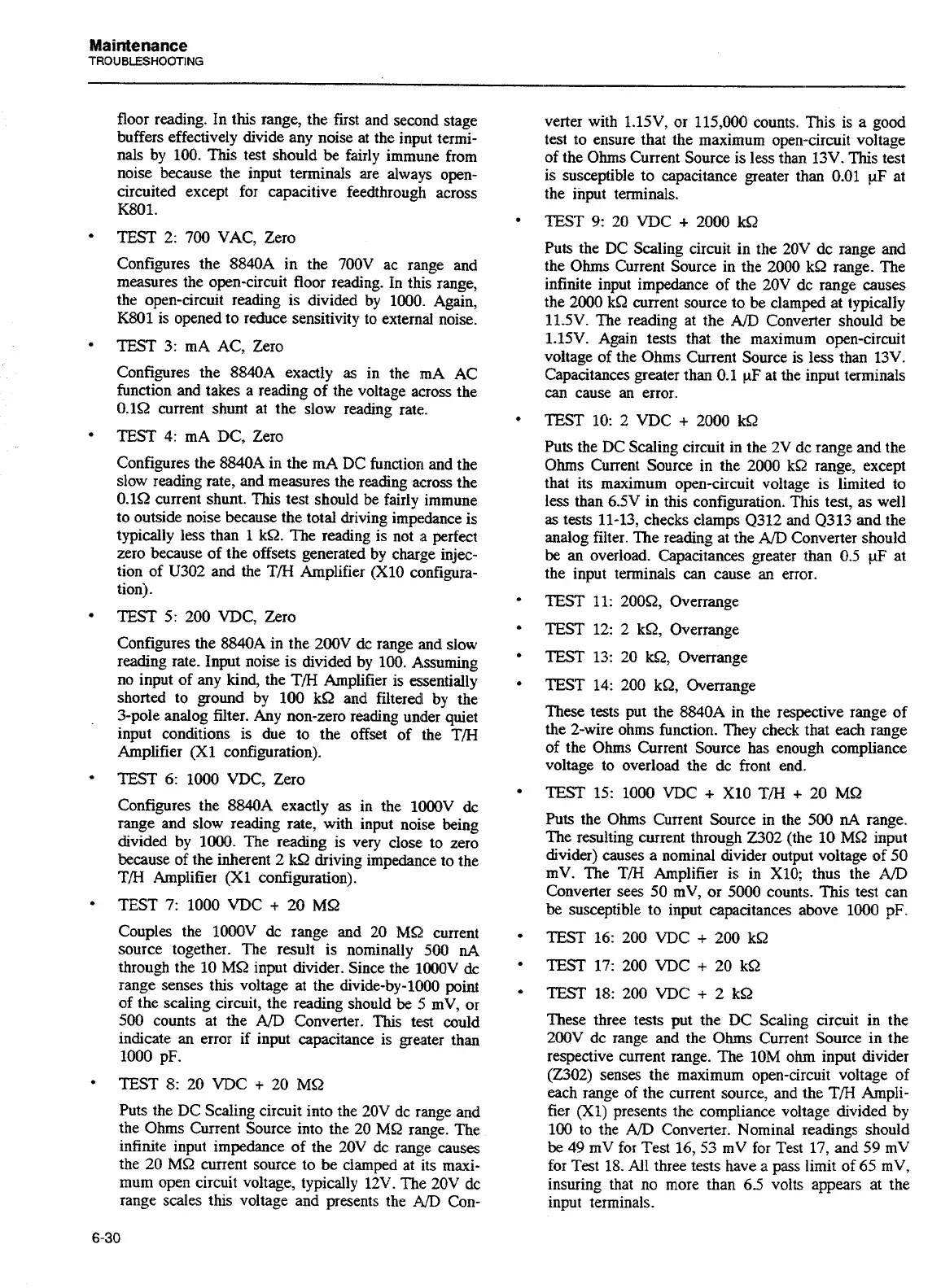Maintenance
TROUBLESHOOTING
floor reading. In this range, the first and second stage
buffers effectively divide any noise at the input termi-
nals by 100. This test should be fairly immune from
noise because the input terminals are always
open-
circuited except for capacitive feedthrough across
K80
1.
TEST 2: 700 VAC, Zero
Configures the 8840A in the 700V ac range and
measures the open-circuit floor reading. In this range,
the open-circuit reading is divided by
1000. Again,
K801 is opened to reduce sensitivity to external noise.
TEST 3: mA AC, Zero
Configures the 8840A exactly
as
in the mA AC
function and takes a reading of the voltage across the
0.1Q current shunt at the slow reading rate.
TEST 4: mA
DC,
Zero
Configures the 8840A in the mA DC function and the
slow reading rate, and measures the reading across the
0.1Q current shunt. This test should be fairly immune
to outside noise because the total driving impedance is
typically less than 1
kQ. The reading is not
a
perfect
zero because of the offsets generated by charge injec-
tion of U302 and the
T/H Amplifier (XI0 configura-
tion).
TEST 5: 200
VDC, Zero
Configures the
8840A in the 200V dc range and slow
reading rate. Input noise is divided by 100. Assuming
no input of any kind, the T/H Amplifier is essentially
shorted to ground by 100 kS2 and filtered by the
3-pole analog filter. Any non-zero reading under quiet
input conditions is due to the offset of the T/H
Amplifier (XI configuration).
TEST
6:
1000 VDC, Zero
Configures the 8840A exactly
as
in the lOOOV
dc
range and slow reading rate, with input noise being
divided by 1000. The reading is very close to zero
because of the inherent 2 kQ driving impedance to the
T/H Amplifier (X1 configuration).
TEST 7: 1000 VDC
+
20 MQ
Couples the lOOOV dc range and 20
MQ
current
source together. The result is nominally 500
nA
through the 10 MQ input divider. Since the lOOOV dc
range senses this voltage at the divide-by-1000 point
of the scaling circuit, the reading should
be
5
mV, or
500 counts at the
A/D
Converter. This test could
indicate an error if input capacitance is greater than
1000 pF.
TEST
8:
20
VDC
+
20 MQ
Puts the DC Scaling circuit into the 20V dc range and
the Ohms Current Source into the 20
MSZ
range. The
infinite input impedance of the 20V dc range causes
the 20
MQ
current source to be clamped at its maxi-
mum open circuit voltage, typically 12V.
The
20V dc
range scales this voltage and presents the
A/D
Con-
verter with 1.15V, or 115,000 counts. This is a good
test to ensure that the maximum open-circuit voltage
of the Ohms Current Source is less than 13V. This test
is susceptible to capacitance greater than 0.01
pF
at
the input terminals.
TEST
9:
20 VDC
+
2000 kQ
Puts the DC Scaling circuit in the 20V dc range and
the Ohms Current Source in the 2000 kQ range. The
infinite input impedance of the 20V dc range causes
the 2000
kQ current source to
be
clamped at typically
11.5V. The reading at the
AX)
Converter should
be
1.15V. Again tests that the maximum open-circuit
voltage of the Ohms Current Source is less than 13V.
Capacitances greater than 0.1
pF
at the input terminals
can
cause an error.
TEST 10: 2 VDC
+
2000 kQ
Puts the DC Scaling circuit in the
2V
dc range and the
Ohms Current Source in the 2000
kQ
range, except
that its maximum open-circuit voltage
is
limited to
less than 6.5V in this configuration. This test, as well
as
tests 11-13, checks clamps Q312 and Q313 and the
analog filter. The reading at the
AID
Converter should
be
an overload. Capacitances greater than 0.5
pF
at
the input terminals can cause
an
error.
TEST
11:
200S2, Overrange
TEST 12: 2 kQ, Overrange
TEST 13: 20 kQ, Overrange
TEST 14: 200 k&, Overrange
These tests put the 8840A in the respective range of
the 2-wire ohms function. They check that each range
of the Ohms Current Source has enough compliance
voltage to overload the dc front end.
TEST 15: 1000 VDC
+
XI0 T/H
+
20 MQ
Puts the Ohms Current Source in the 500
nA
range.
The resulting current through 2302 (the 10 MQ input
divider) causes a nominal divider output voltage of 50
mV. The T/H Amplifier is in X10; thus the
AD
Converter sees 50 mV, or 5000 counts. This test can
be
susceptible to input capacitances above 1000
pF.
TEST 16: 200 VDC
+
200 kQ
TEST
17: 200
VDC
+
20 kQ
TEST
18:
200
VDC
+
2 kQ
These three tests put the DC Scaling circuit in the
200V dc range and the Ohms Current Source in the
respective current range. The 10M ohm input divider
(2302) senses the maximum open-circuit voltage of
each range of the current source, and the T/H Ampli-
fier
(XI) presents the compliance voltage divided by
100 to the
AID
Converter. Nominal readings should
be 49 mV for Test 16,53 mV for Test 17, and 59 mV
for Test 18. All three tests have
a
pass limit of 65 mV,
insuring that no more than
65
volts appears at the
input terminals.
Artisan Technology Group - Quality Instrumentation ... Guaranteed | (888) 88-SOURCE | www.artisantg.com

